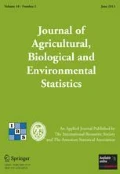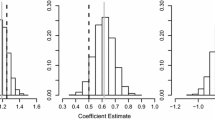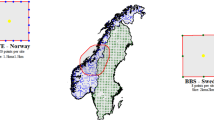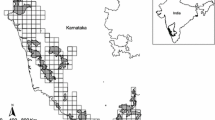Abstract
We consider a model-based clustering approach to examining abundance trends in a metapopulation. When examining trends for an animal population with management goals in mind one is often interested in those segments of the population that behave similarly to one another with respect to abundance. Our proposed trend analysis incorporates a clustering method that is an extension of the classic Chinese Restaurant Process, and the associated Dirichlet process prior, which allows for inclusion of distance covariates between sites. This approach has two main benefits: (1) nonparametric spatial association of trends and (2) reduced dimension of the spatio-temporal trend process. We present a transdimensional Gibbs sampler for making Bayesian inference that is efficient in the sense that all of the full conditionals can be directly sampled from save one. To demonstrate the proposed method we examine long term trends in northern fur seal pup production at 19 rookeries in the Pribilof Islands, Alaska. There was strong evidence that clustering of similar year-to-year deviation from linear trends was associated with whether rookeries were located on the same island. Clustering of local linear trends did not seem to be strongly associated with any of the distance covariates. In the fur seal trends analysis an overwhelming proportion of the MCMC iterations produced a 73–79 % reduction in the dimension of the spatio-temporal trend process, depending on the number of cluster groups.
Similar content being viewed by others
References
Blei, D. M., and Frazier, P. I. (2011), “Distance Dependent Chinese Restaurant Processes,” Journal of Machine Learning Research, 12, 2461–2488.
Call, K. A., Ream, R. R., Johnson, D., Sterling, J. T., and Towell, R. G. (2008), “Foraging Route Tactics and Site Fidelity of Adult Female Northern fur Seal (Callorhinus Ursinus) Around the Pribilof Islands,” Deep-Sea Research. Part 2. Topical Studies in Oceanography, 55, 1883–1896.
Chapman, D. G., and Johnson, A. M. (1968), “Estimation of fur Seal Pup Populations by Randomized Sampling,” Transactions of the American Fisheries Society, 97 (3), 264–270.
Dorazio, R. M. (2009), “On Selecting a Prior for the Precision Parameter of Dirichlet Process Mixture Models,” Journal of Statistical Planning and Inference, 139 (9), 3384–3390.
Dorazio, R. M., Mukherjee, B., Zhang, L., Ghosh, M., Jelks, H. L., and Jordan, F. (2008), “Modeling Unobserved Sources of Heterogeneity in Animal Abundance Using a Dirichlet Process Prior,” Biometrics, 64 (2), 635–644.
Escobar, M., and West, M. (1995), “Bayesian Density-Estimation and Inference Using Mixtures,” Journal of the American Statistical Association, 90 (430), 577–588.
Ferguson, T. S. (1973), “A Bayesian Analysis of Some Nonparametric Problems,” The Annals of Statistics, 1, 209–230.
Gentry, R. L. (1998), Behavior and Ecology of the Northern fur Seal, Princeton: Princeton University Press.
Johnson, D. S., and Hoeting, J. A. (2011), “Bayesian Multimodel Inference for Geostatistical Regression Models,” PLoS ONE, 6 (11), e25677.
MacEachern, S., and Muller, P. (1998), “Estimating Mixture of Dirichlet Process Models,” Journal of Computational and Graphical Statistics, 7 (2), 223–238.
Muller, P., and Quintana, F. A. (2004), “Nonparametric Bayesian Data Analysis,” Statistical Science, 19, 95–110.
Neal, R. (2000), “Markov Chain Sampling Methods for Dirichlet Process Mixture,” Journal of Computational and Graphical Statistics, 9 (2), 249–265.
Pitman, J. (2006), Combinatorial Stochastic Processes, Berlin: Springer.
(R Core Team) (2012), R: A Language and Environment for Statistical Computing, Vienna: R Foundation for Statistical Computing. ISBN:3-900051-07-0
Ross, B. E., Hooten, M. B., and Koons, D. N. (2012), “An Accessible Method for Implementing Hierarchical Models with Spatio-Temporal Abundance Data,” PLoS ONE, 7, e49395.
Royle, J. A., and Dorazio, R. M. (2008), Hierarchical Modeling and Inference in Ecology, San Diego: Academic Press-Elsevier.
Rue, H., and Held, L. (2005), Gaussian Markov Random Fields: Theory and Applications. Monographs on Statistics and Applied Probability, Vol. 104, London: Chapman & Hall.
Stein, M. L. (2005), “Space-Time Covariance Functions,” Journal of the American Statistical Association, 100 (469), 310–321.
Towell, R., Ream, R., and York, A. (2006), “Decline in Northern fur Seal (Callorhinus Ursinus) Pup Production on the Pribilof Islands,” Marine Mammal Science, 22 (2), 486–491.
Ward, E. J., Chirakkal, H., Gonzalez-Suarez, M., Aurioles-Gamboa, D., Holmes, E. E., and Gerber, L. (2010), “Inferring Spatial Structure from Time-Series Data: Using Multivariate State-Space Models to Detect Metapopulation Structure of California Sea Lions in the Gulf of California, Mexico,” Journal of Applied Ecology, 47 (1), 47–56.
York, A., and Kozloff, P. (1987), “On the Estimation of the Numbers of Northern fur Seal, Callorhinus Ursinus Pups Born on St. Paul Island, 1980–86,” Fisheries Bulletin, 85, 367–375.
Zeppelin, T. K., and Ream, R. R. (2006), “Foraging Habitats Based on the Diet of Female Northern fur Seals (Callorhinus Ursinus) on the Pribilof Islands, Alaska,” Journal of Zoology, 270 (4), 565–576.
Author information
Authors and Affiliations
Corresponding author
Rights and permissions
About this article
Cite this article
Johnson, D.S., Ream, R.R., Towell, R.G. et al. Bayesian Clustering of Animal Abundance Trends for Inference and Dimension Reduction. JABES 18, 299–313 (2013). https://doi.org/10.1007/s13253-013-0143-0
Published:
Issue Date:
DOI: https://doi.org/10.1007/s13253-013-0143-0




